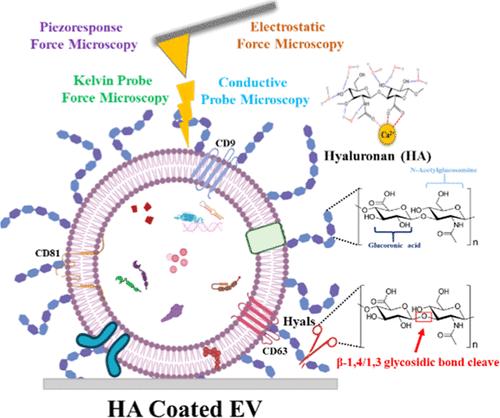基于相关扫描探针显微镜的纳米电模式揭示透明质酸包被肿瘤细胞外囊泡的电学性质
IF 8.2
2区 材料科学
Q1 MATERIALS SCIENCE, MULTIDISCIPLINARY
引用次数: 0
摘要
癌细胞在细胞外基质中产生包被阴离子糖聚合物透明质酸(HA)的细胞外囊泡(ev)。透明质酸是几种癌症类型的确定的癌症生物标志物。在这项工作中,我们使用先进的扫描探针显微镜(SPM)为基础的纳米电模式,包括EFM(静电力显微镜),KPFM(开尔文探针力显微镜),PFM(压电响应力显微镜)和C-AFM(导电原子力显微镜),深入研究了ha涂层电动汽车的电学性能。分析结果显示,在单囊泡分辨率下,不同组的电动汽车在表面电位、电荷分布和压电机电响应方面具有不同的特性。典型的电子传递能力主要是由夹在EV结中的离子驱动的。这种相关方法基本上可以区分ha包被的癌症EV (cev)和正常EV (nev)。基于spm的纳米电模式组合为电动汽车的电性能评估提供了多路一站式无标签解决方案。这一策略有助于开发基于电动汽车的生物电子传感器。本文章由计算机程序翻译,如有差异,请以英文原文为准。

Unveiling the Electrical Properties of Hyaluronan-Coated Cancer Extracellular Vesicles Using Correlative Scanning Probe Microscopy-Based Nano-Electrical Modes
Cancer cells produce extracellular vesicles (EVs) coated with an anionic sugar polymer, hyaluronan (HA), in the extracellular matrix. Hyaluronan is an established cancer biomarker in several cancer types. In this work, we thoroughly investigated the electrical properties of HA-coated EVs using advanced scanning probe microscopy (SPM) based nanoelectrical modes, which include EFM (electrostatic force microscopy), KPFM (Kelvin probe force microscopy), PFM (piezoresponse force microscopy) and C-AFM (conductive atomic force microscopy). Analyses revealed distinct properties for different sets of EVs regarding surface potential, charge distribution, and piezoelectric electro-mechanical response at the single-vesicle resolution. The typical electron transport capabilities are primarily driven by ions in sandwiched EV junctions. This correlative approach essentially could distinguish HA-coated cancer EVs (CEVs) from normal EV (NEVs) counterparts. The combined SPM-based nanoelectrical modes offered a multiplexed one-stop label-free solution for EV’s electrical property assessments. This strategy is useful in developing EV-based bioelectronic sensors.
求助全文
通过发布文献求助,成功后即可免费获取论文全文。
去求助
来源期刊

ACS Applied Materials & Interfaces
工程技术-材料科学:综合
CiteScore
16.00
自引率
6.30%
发文量
4978
审稿时长
1.8 months
期刊介绍:
ACS Applied Materials & Interfaces is a leading interdisciplinary journal that brings together chemists, engineers, physicists, and biologists to explore the development and utilization of newly-discovered materials and interfacial processes for specific applications. Our journal has experienced remarkable growth since its establishment in 2009, both in terms of the number of articles published and the impact of the research showcased. We are proud to foster a truly global community, with the majority of published articles originating from outside the United States, reflecting the rapid growth of applied research worldwide.
 求助内容:
求助内容: 应助结果提醒方式:
应助结果提醒方式:


